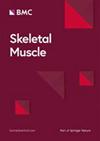Studying intramuscular fat deposition and muscle regeneration: insights from a comparative analysis of mouse strains, injury models, and sex differences
IF 4.4
2区 医学
Q2 CELL BIOLOGY
引用次数: 0
Abstract
Intramuscular fat (IMAT) infiltration, pathological adipose tissue that accumulates between muscle fibers, is a shared hallmark in a diverse set of diseases including muscular dystrophies and diabetes, spinal cord and rotator cuff injuries, as well as sarcopenia. While the mouse has been an invaluable preclinical model to study skeletal muscle diseases, they are also resistant to IMAT formation. To better understand this pathological feature, an adequate pre-clinical model that recapitulates human disease is necessary. To address this gap, we conducted a comprehensive in-depth comparison between three widely used mouse strains: C57BL/6J, 129S1/SvlmJ and CD1. We evaluated the impact of strain, sex and injury type on IMAT formation, myofiber regeneration and fibrosis. We confirm and extend previous findings that a Glycerol (GLY) injury causes significantly more IMAT and fibrosis compared to Cardiotoxin (CTX). Additionally, females form more IMAT than males after a GLY injury, independent of strain. Of all strains, C57BL/6J mice, both females and males, are the most resistant to IMAT formation. In regard to injury-induced fibrosis, we found that the 129S strain formed the least amount of scar tissue. Surprisingly, C57BL/6J of both sexes demonstrated complete myofiber regeneration, while both CD1 and 129S1/SvlmJ strains still displayed smaller myofibers 21 days post injury. In addition, our data indicate that myofiber regeneration is negatively correlated with IMAT and fibrosis. Combined, our results demonstrate that careful consideration and exploration are needed to determine which injury type, mouse model/strain and sex to utilize as preclinical model especially for modeling IMAT formation.研究肌肉内脂肪沉积和肌肉再生:从小鼠品系、损伤模型和性别差异的比较分析中获得启示
肌内脂肪(IMAT)浸润是堆积在肌肉纤维之间的病理性脂肪组织,是多种疾病的共同特征,包括肌肉萎缩症和糖尿病、脊髓和肩袖损伤以及肌肉疏松症。虽然小鼠一直是研究骨骼肌疾病的宝贵临床前模型,但它们对 IMAT 的形成也有抵抗力。为了更好地了解这一病理特征,有必要建立一个能再现人类疾病的适当临床前模型。为了填补这一空白,我们对三种广泛使用的小鼠品系进行了全面深入的比较:C57BL/6J、129S1/SvlmJ 和 CD1。我们评估了品系、性别和损伤类型对 IMAT 形成、肌纤维再生和纤维化的影响。我们证实并扩展了之前的研究结果,即甘油(GLY)损伤与心脏毒素(CTX)相比,会导致更多的IMAT和纤维化。此外,在甘油损伤后,雌性比雄性形成更多的IMAT,这与品系无关。在所有品系中,C57BL/6J小鼠(包括雌性和雄性)对IMAT形成的抵抗力最强。在损伤诱导的纤维化方面,我们发现 129S 品系形成的瘢痕组织最少。令人惊讶的是,C57BL/6J雌雄小鼠的肌纤维完全再生,而 CD1 和 129S1/SvlmJ 品系在损伤后 21 天仍显示较小的肌纤维。此外,我们的数据还表明,肌纤维再生与 IMAT 和纤维化呈负相关。综上所述,我们的研究结果表明,在确定使用哪种损伤类型、小鼠模型/品系和性别作为临床前模型,尤其是 IMAT 形成模型时,需要仔细考虑和探索。
本文章由计算机程序翻译,如有差异,请以英文原文为准。
求助全文
约1分钟内获得全文
求助全文
来源期刊

Skeletal Muscle
CELL BIOLOGY-
CiteScore
9.10
自引率
0.00%
发文量
25
审稿时长
12 weeks
期刊介绍:
The only open access journal in its field, Skeletal Muscle publishes novel, cutting-edge research and technological advancements that investigate the molecular mechanisms underlying the biology of skeletal muscle. Reflecting the breadth of research in this area, the journal welcomes manuscripts about the development, metabolism, the regulation of mass and function, aging, degeneration, dystrophy and regeneration of skeletal muscle, with an emphasis on understanding adult skeletal muscle, its maintenance, and its interactions with non-muscle cell types and regulatory modulators.
Main areas of interest include:
-differentiation of skeletal muscle-
atrophy and hypertrophy of skeletal muscle-
aging of skeletal muscle-
regeneration and degeneration of skeletal muscle-
biology of satellite and satellite-like cells-
dystrophic degeneration of skeletal muscle-
energy and glucose homeostasis in skeletal muscle-
non-dystrophic genetic diseases of skeletal muscle, such as Spinal Muscular Atrophy and myopathies-
maintenance of neuromuscular junctions-
roles of ryanodine receptors and calcium signaling in skeletal muscle-
roles of nuclear receptors in skeletal muscle-
roles of GPCRs and GPCR signaling in skeletal muscle-
other relevant aspects of skeletal muscle biology.
In addition, articles on translational clinical studies that address molecular and cellular mechanisms of skeletal muscle will be published. Case reports are also encouraged for submission.
Skeletal Muscle reflects the breadth of research on skeletal muscle and bridges gaps between diverse areas of science for example cardiac cell biology and neurobiology, which share common features with respect to cell differentiation, excitatory membranes, cell-cell communication, and maintenance. Suitable articles are model and mechanism-driven, and apply statistical principles where appropriate; purely descriptive studies are of lesser interest.
 求助内容:
求助内容: 应助结果提醒方式:
应助结果提醒方式:


